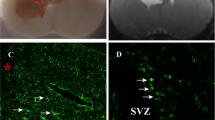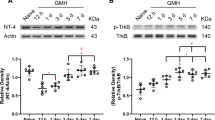Abstract
Germinal matrix hemorrhage (GMH) is the most common neurological disease of premature newborns leading to detrimental neurological sequelae. Minocycline has been reported to play a key role in neurological inflammatory diseases by controlling some mechanisms that involve cannabinoid receptor 2 (CB2R). The current study investigated whether minocycline reduces neuroinflammation and protects the brain from injury in a rat model of collagenase-induced GMH by regulating CB2R activity. To test this hypothesis, the effects of minocycline and a CB2R antagonist (AM630) were evaluated in male rat pups that were post-natal day 7 (P7) after GMH. We found that minocycline can lead to increased CB2R mRNA expression and protein expression in microglia. Minocycline significantly reduced GMH-induced brain edema, microglial activation, and lateral ventricular volume. Additionally, minocycline enhanced cortical thickness after injury. All of these neuroprotective effects of minocycline were prevented by AM630. A cannabinoid CB2 agonist (JWH133) was used to strengthen the hypothesis, which showed the identical neuroprotective effects of minocycline. Our study demonstrates, for the first time, that minocycline attenuates neuroinflammation and brain injury in a rat model of GMH, and activation of CBR2 was partially involved in these processes.








Similar content being viewed by others
References
Heron M et al (2010) Annual summary of vital statistics: 2007. Pediatrics 125(1):4–15
Shennan AH, Bewley S (2006) Why should preterm births be rising? BMJ 332(7547):924–5
Ballabh P (2010) Intraventricular hemorrhage in premature infants: mechanism of disease. Pediatr Res 67(1):1–8
Ballabh P, Braun A, Nedergaard M (2004) The blood-brain barrier: an overview: structure, regulation, and clinical implications. Neurobiol Dis 16(1):1–13
Murphy BP et al (2002) Posthaemorrhagic ventricular dilatation in the premature infant: natural history and predictors of outcome. Arch Dis Child Fetal Neonatal Ed 87(1):F37–41
Xi G, Keep RF, Hoff JT (2006) Mechanisms of brain injury after intracerebral haemorrhage. Lancet Neurol 5(1):53–63
Chen Z et al (2011) Role of iron in brain injury after intraventricular hemorrhage. Stroke 42(2):465–70
Lekic T et al (2012) Rodent neonatal germinal matrix hemorrhage mimics the human brain injury, neurological consequences, and post-hemorrhagic hydrocephalus. Exp Neurol 236(1):69–78
Streit WJ, Walter SA, Pennell NA (1999) Reactive microgliosis. Prog Neurobiol 57(6):563–81
Supramaniam V et al (2013) Microglia activation in the extremely preterm human brain. Pediatr Res 73(3):301–9
Yang S et al (2006) The role of complement C3 in intracerebral hemorrhage-induced brain injury. J Cereb Blood Flow Metab 26(12):1490–5
Aronson AL (1980) Pharmacotherapeutics of the newer tetracyclines. J Am Vet Med Assoc 176(10 Spec No):1061–8
Tikka T et al (2001) Minocycline, a tetracycline derivative, is neuroprotective against excitotoxicity by inhibiting activation and proliferation of microglia. J Neurosci 21(8):2580–8
Wasserman JK, Schlichter LC (2007) Minocycline protects the blood-brain barrier and reduces edema following intracerebral hemorrhage in the rat. Exp Neurol 207(2):227–37
Wu J et al (2010) Minocycline attenuates brain edema, brain atrophy and neurological deficits after intracerebral hemorrhage. Acta Neurochir Suppl 106:147–50
Chu LS et al (2010) Minocycline inhibits 5-lipoxygenase expression and accelerates functional recovery in chronic phase of focal cerebral ischemia in rats. Life Sci 86(5–6):170–7
Plane JM et al (2010) Prospects for minocycline neuroprotection. Arch Neurol 67(12):1442–8
Tikka TM, Koistinaho JE (2001) Minocycline provides neuroprotection against N-methyl-D-aspartate neurotoxicity by inhibiting microglia. J Immunol 166(12):7527–33
Markovic DS et al (2011) Minocycline reduces glioma expansion and invasion by attenuating microglial MT1-MMP expression. Brain Behav Immun 25(4):624–8
Mackie K (2006) Cannabinoid receptors as therapeutic targets. Annu Rev Pharmacol Toxicol 46:101–22
Piomelli D (2003) The molecular logic of endocannabinoid signalling. Nat Rev Neurosci 4(11):873–84
Chin CL et al (2008) Differential effects of cannabinoid receptor agonists on regional brain activity using pharmacological MRI. Br J Pharmacol 153(2):367–79
Fernandez-Lopez D et al (2012) Reduced infarct size and accumulation of microglia in rats treated with WIN 55,212-2 after neonatal stroke. Neuroscience 207:307–15
Choi IY et al (2013) Activation of cannabinoid CB2 receptor-mediated AMPK/CREB pathway reduces cerebral ischemic injury. Am J Pathol 182(3):928–39
Eljaschewitsch E et al (2006) The endocannabinoid anandamide protects neurons during CNS inflammation by induction of MKP-1 in microglial cells. Neuron 49(1):67–79
Sarne Y et al (2011) The dual neuroprotective-neurotoxic profile of cannabinoid drugs. Br J Pharmacol 163(7):1391–401
Chen Y, Buck J (2000) Cannabinoids protect cells from oxidative cell death: a receptor-independent mechanism. J Pharmacol Exp Ther 293(3):807–12
Sarker KP et al (2000) Anandamide induces apoptosis of PC-12 cells: involvement of superoxide and caspase-3. FEBS Lett 472(1):39–44
Kozela E et al (2010) Cannabinoids Delta(9)-tetrahydrocannabinol and cannabidiol differentially inhibit the lipopolysaccharide-activated NF-kappaB and interferon-beta/STAT proinflammatory pathways in BV-2 microglial cells. J Biol Chem 285(3):1616–26
Lopez Rodriguez AB et al (2011) Estradiol decreases cortical reactive astrogliosis after brain injury by a mechanism involving cannabinoid receptors. Cereb Cortex 21(9):2046–55
Wu J et al (2009) Minocycline reduces intracerebral hemorrhage-induced brain injury. Neurol Res 31(2):183–8
Huffman JW et al (1999) 3-(1',1'-Dimethylbutyl)-1-deoxy-delta8-THC and related compounds: synthesis of selective ligands for the CB2 receptor. Bioorg Med Chem 7(12):2905–14
Zarruk JG et al (2012) Cannabinoid type 2 receptor activation downregulates stroke-induced classic and alternative brain macrophage/microglial activation concomitant to neuroprotection. Stroke 43(1):211–9
Diz-Chaves Y et al (2012) Prenatal stress causes alterations in the morphology of microglia and the inflammatory response of the hippocampus of adult female mice. J Neuroinflammation 9:71
Ashton JC et al (2007) Cerebral hypoxia-ischemia and middle cerebral artery occlusion induce expression of the cannabinoid CB2 receptor in the brain. Neurosci Lett 412(2):114–7
Tang J et al (2005) Role of NADPH oxidase in the brain injury of intracerebral hemorrhage. J Neurochem 94(5):1342–50
Newson P et al (2005) Intrinsic sensory deprivation induced by neonatal capsaicin treatment induces changes in rat brain and behaviour of possible relevance to schizophrenia. Br J Pharmacol 146(3):408–18
Homsi S et al (2009) Minocycline effects on cerebral edema: relations with inflammatory and oxidative stress markers following traumatic brain injury in mice. Brain Res 1291:122–32
Lopez-Rodriguez, A.B..., et al. (2013) CB1 and CB2 Cannabinoid Receptor Antagonists Prevent Minocycline-Induced Neuroprotection Following Traumatic Brain Injury in Mice. Cereb Cortex
Sun J et al (2013) WIN55,212-2 protects oligodendrocyte precursor cells in stroke penumbra following permanent focal cerebral ischemia in rats. Acta Pharmacol Sin 34(1):119–28
Fujii M et al (2014) Cannabinoid receptor type 2 agonist attenuates apoptosis by activation of phosphorylated CREB-Bcl-2 pathway after subarachnoid hemorrhage in rats. Exp Neurol 261:396–403
Rivest S (2006) Cannabinoids in microglia: a new trick for immune surveillance and neuroprotection. Neuron 49(1):4–8
Moller T, Hanisch UK, Ransom BR (2000) Thrombin-induced activation of cultured rodent microglia. J Neurochem 75(4):1539–47
Lazovic J et al (2005) Neuroinflammation and both cytotoxic and vasogenic edema are reduced in interleukin-1 type 1 receptor-deficient mice conferring neuroprotection. Stroke 36(10):2226–31
Strahle J et al (2012) Mechanisms of hydrocephalus after neonatal and adult intraventricular hemorrhage. Transl Stroke Res 3(Suppl 1):25–38
Grainger DJ et al (1995) Release and activation of platelet latent TGF-beta in blood clots during dissolution with plasmin. Nat Med 1(9):932–7
Bottner M, Krieglstein K, Unsicker K (2000) The transforming growth factor-betas: structure, signaling, and roles in nervous system development and functions. J Neurochem 75(6):2227–40
Romero-Sandoval EA et al (2009) Cannabinoid receptor type 2 activation induces a microglial anti-inflammatory phenotype and reduces migration via MKP induction and ERK dephosphorylation. Mol Pain 5:25
Hua Y et al (2006) Tumor necrosis factor-alpha increases in the brain after intracerebral hemorrhage and thrombin stimulation. Neurosurgery 58(3):542–50, discussion 542-50
Wasserman JK, Zhu X, Schlichter LC (2007) Evolution of the inflammatory response in the brain following intracerebral hemorrhage and effects of delayed minocycline treatment. Brain Res 1180:140–54
Poralla C et al (2012) Elevated interleukin-6 concentration and alterations of the coagulation system are associated with the development of intraventricular hemorrhage in extremely preterm infants. Neonatology 102(4):270–5
Acknowledgments
The National Science Foundation of China (NSFC, number81271281) and National “973” Project of China (2014 CB541605) supported this work. We gratefully thank Professor John H Zhang from Loma Linda University for his generous assistance regarding the model induction, and we gratefully thank Professor Guohua Xi from the University of Michigan and Liu Xin for their constructive suggestions regarding the experimental processes.
Conflict of Interest
The authors declare no competing interests.
Author information
Authors and Affiliations
Corresponding authors
Electronic supplementary material
Below is the link to the electronic supplementary material.
Fig. S1
Effects of JWH133 and minocycline on brain edema after GMH JWH133 administration 24 h after GMH induction shared the identical effect of minocycline, which induced less brain edema compared with the GMH-induced pups that received the vehicle treatment (n = 12). The data are means ± S.D., * P < 0.05, N.S.: no significant differences were detected. (GIF 27 kb)
Fig. S2
Effects of JWH133 and minocycline on lateral ventricular volume after GMH 28d following GMH, 7.0 T MRI showed the coronal section of pup’s brain after JWH133 or minocycline or the vehicle administration (A). Analysis of the lateral ventricular volume with Image J demonstrated that JWH133 and minocycline share the identical effect on decreasing the volume following GMH (B, n = 6). The data are means ± S.D., * P < 0.05 N.S.: no significant differences were detected. (GIF 98 kb)
Fig. S3
Effects of JWH133 on P-ERK protein expression after GMH Sections were stained against Iba-1 (red) and phosphorylated p-ERK (green) antibody as described in the Material and Methods. Sham controls (A), GMH + vehi. (B), GMH+ JWH133 (C), white arrows refer to p-ERK+/Iba-1+ microglia; Vehi. = vehicle; Scale bar = 50 μm. P-ERK positive microglia were counted up in every field (D, n = 6/ each group). Western blotting was used for analysis of p-ERK protein level (E, n = 6) and quantification of relative density of bands was determined by Image J. *p < 0.05, **p < 0.01. (GIF 250 kb)
Rights and permissions
About this article
Cite this article
Tang, J., Chen, Q., Guo, J. et al. Minocycline Attenuates Neonatal Germinal-Matrix-Hemorrhage-Induced Neuroinflammation and Brain Edema by Activating Cannabinoid Receptor 2. Mol Neurobiol 53, 1935–1948 (2016). https://doi.org/10.1007/s12035-015-9154-x
Received:
Accepted:
Published:
Issue Date:
DOI: https://doi.org/10.1007/s12035-015-9154-x




